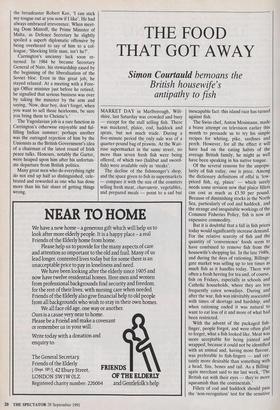THE FOOD THAT GOT AWAY
Simon Courtauld bemoans the British housewife's antipathy to fish
MARKET DAY in Marlborough, Wilt- shire, last Saturday was crowded and busy — except for the stall selling fish. There was mackerel, plaice, cod, haddock and sprats, but not much trade. During a five-minute period the only sale was of a quarter-pound bag of piawns. At the Wait- rose supermarket in the same street, no more than seven fresh fish were being offered, of which two (halibut and sword- fish) were available only as 'steaks'.
The decline of the fishmonger's shop, and the space given to fish in supermarkets — compare it with the size of the counters selling fresh meat, charcuterie, vegetables, and prepared meals — point to a sad but
inescapable fact: this island race has turned against fish.
The Swiss chef, Anton Mosimann, made a brave attempt on television earlier this month to persuade us to try his simple recipes for whiting, pike, sardines and perch. However, for all the effect it will have had on the eating habits of the average British family, he might as well have been speaking in his native tongue.
Of the several reasons for the unpopu- larity of fish today, one is price. Among the dictionary definitions of offal is 'low- priced fish, eg, plaice' — which surely needs some revision now that plaice fillets can cost as much as £3.50 per pound. Because of diminishing stocks in the North Sea, particularly of cod and haddock, and the strange and inequitable workings of the Common Fisheries Policy, fish is now an expensive commodity.
But it is doubtful that a fall in fish prices today would significantly increase demand. For the relative scarcity of fish and the quantity of 'convenience' foods seem to have combined to remove fish from the housewife's shopping list. In the late 1940s, and during the days of rationing, Billings- gate market was selling up to ten times as much fish as it handles today. There was often a fresh herring for tea and, of course, fish on Fridays, especially in schools and Catholic households, where they are less frequently eaten nowadays. During and after the war, fish was inevitably associated with times of shortage and hardship; and when rationing ended it was natural to want to eat less of it and more of what had been restricted.
With the advent of the packaged fish- finger, people forgot, and were often glad to forget, what a fish looked like. Meat was more acceptable for being jointed and wrapped, because it could not be identified with an animal and, having more flavour, was preferable to fish-fingers — and cer- tainly more desirable than something with a head, fins, bones and tail. As a Billing- sgate merchant said to me last week, 'The British eat with their eyes — they're more squeamish than the continentals.' Fillets of cod and haddock should pass the 'non-recognition' test for the sensitive
British consumer, but they are expensive and likely to become more so. According to a former fishery scientist at the Ministry of Agriculture, these fish may soon dis- appear from the North Sea unless the number of fishing vessels in the European Community is cut by 40 per cent. The Common Fisheries Policy has hit British fishermen hardest — because of the prop- ortion of the Total Allowable Catch allo- cated to them, and the regulations on net mesh sizes and juvenile fish. With a quota system which has proved ineffective, Bri- tain's fishermen are obliged to limit their catches, knowing that other EEC fisher- men, from countries with far fewer inspec- tors than Britain, ignore the Common Fisheries policy restrictions with impunity. The Seafish Industry Authority, succes- sor to the Whitefish Authority, should be doing more to encourage the eating of fish in Britain. It would surely be possible to launch a successful campaign to promote fish as a health food.
Europeans need no such encourage- ment, because to them fish-eating comes naturally; so does the inspection of a fish, checking eyes and gills for freshness, be- fore buying it, at the local market. There is nothing in Britain to match the fish market to be found in every coastal European town.
. Meanwhile, at Billingsgate the pattern of fish-buying is changing in a quite remark- able way. These days, as the merchants will tell you, the trend is towards 'exotics for ethnics' — which means warm-water fish sold to the immigrant communities. One Billingsgate merchant has a list of 72 exotic species which he imports mainly from the Gulf, the Caribbean and Austra- lasia. They are sold to market shops in places such as Brixton, to ethnic res- taurants, a few 'up-market' fishmongers in central London — and the increasing number of people who go to Billingsgate on a Saturday morning. On that day, I was told, 'you can hardly move; and apart from the merchants you don't see a white face'. Most of the exotic fish can be bought individually whereas you would get a very old-fashioned response if you asked a merchant for one herring. And many of them are cheap: trevally, from New Zea- land, costs about 70 pence per pound and is very popular with West Indians.
This is all very well; but is the great British housewife going to be seduced by the exotics? She might try them if they were filleted and the coloured skin re- moved. But then there is also a problem with the names. Around our coasts there are perfectly good eating fish but with unappealing names — tope, gurnard, wras- se — which is surely why housewives have never taken to them. What would they do if confronted in a supermarket with the not so black-spotted rubberlip? Or the silver grunt, crocodile needle fish, squirrel fish or banded spinecheek? Alas, they would pass by on the other side.



































































 Previous page
Previous page